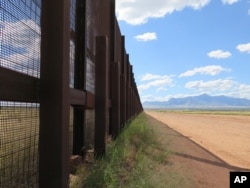Donald Trump, the front-runner for the U.S. Republican presidential nomination, said Tuesday he would force Mexico to pay for a border wall to block the stream of illegal immigrants into the United States by threatening to cut off billions of dollars that Mexicans already in the U.S. send home to family members.
But later in the day, President Barack Obama denounced the idea, saying that world leaders "don't expect half-baked notions coming out of the White House."
Obama said that hobbling the Mexican economy by cutting off remittances from Mexicans who work in the U.S. to families in their homeland could lead to even more attempts by immigrants to try to flee to the United States. He said Trump's idea was "primarily put forward for political consumption."
Trump's call for a massive, impenetrable wall along the southern U.S. border with Mexico has been a cornerstone of his unexpected surge to the top of the Republican nomination contest, routinely drawing cheers at his campaign rallies from his supporters who want to curb illegal immigration into the country.
Remittances targeted
His critics have often scoffed at his idea and Trump had provided few clues about how he would pay for what he says would be an $8 billion, 1,600-kilometer wall. But in a two-page memo he sent to The Washington Post, the billionaire real estate mogul said that if he is elected president he would threaten to change a rule under a U.S. anti-terrorism law to cut off the remittances sent home by Mexican immigrants in the U.S., many of whom crossed the border illegally.
There are about 11 million undocumented immigrants living in the U.S., about half of them Mexicans, and millions more Mexicans live in the U.S. legally or have become U.S. citizens.
Mexicans living abroad, not just in the U.S., annually send about $25 billion home to relatives and friends. Trump said "the majority of that amount comes from illegal aliens."
Some analysts say that withdrawing a large portion of the amount sent home could devastate the weak economy in Mexico, a staunch ally of the United States.
But Trump said he would withdraw the threat if Mexico made "a one-time payment" of $5 billion to $10 billion to pay for the wall.
Mexico will not pay
Mexico's President Enrique Pena Nieto has said his country has no intention of paying for Trump's prospective wall, a position echoed by former Mexican officials.
While Trump is most associated with his build-a-wall proposal, his chief rival for the Republican presidential nomination, Texas Senator Ted Cruz, says his first priority for immigration reform would be to secure the U.S.-Mexican border.
Cruz, a conservative firebrand, says he would complete a partially constructed barrier that already exists and triple the number of U.S. border agents.
The border proposals come at the time when government officials say there is no net flow of illegal immigrants into the U.S., with as many entering illegally as there are returning to Mexico and Central American countries to the south. The overall number of Mexicans living illegally in the U.S. has dropped in recent years, down about a million since 2007.






